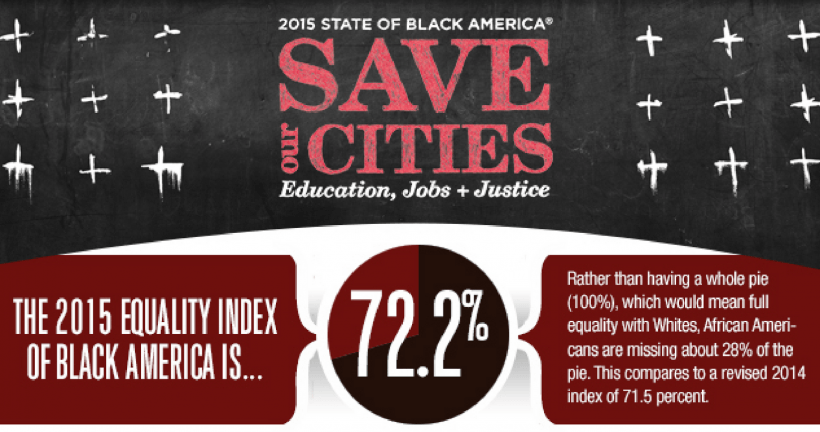
Credit: National Urban League State of Black America Report 2015
The U.S. economy is rebounding, the stock market is thriving, and unemployment is down to levels not seen since the Great Recession. But how is black America doing these days? Not well.
This week, the National Urban League released its 39th annual State of Black America report. And according to the civil rights organization, there is something we should know—black America is in a state of crisis.
The report—available for the first time exclusively in E-book form—provides a detailed and sobering assessment of where African-Americans and Latinos stand with regard to injustice and inequality. Among the major topics covered are civic engagement, criminal justice, education, employment, healthcare, housing, income and poverty. The report was unveiled at a press conference Thursday in Washington, DC.
A cornerstone of the National Urban League study is the Equality Index, which measures how people of color fare with regard to their white counterparts. Overall, the black-white Equality Index is 72.2%, while the Hispanic-White Equality Index is 77.7%. This means that African-Americans and Latinos are doing roughly only three-quarters as well as whites. And while all people are created equal, longstanding policies and entrenched discrimination in America have meant they surely are not all treated that way.
Looking more closely at the details, two areas where blacks fare the worst are in economics (with an Equality Index of only 55.8%) and social justice (60.6%). “We are five years into the recovery, and when you take a snapshot of America, the unemployment rate has come down for everyone except blacks,” Marc H. Morial, President and CEO of the National Urban League, recently told theGrio. “That is pneumonia. You have almost a 3-to-1 ratio between the black unemployment rate and the white unemployment rate.” While the country as a whole lost ground during the Great Recession, as Morial notes, black America also lost ground but has had a difficult time coming back.
According to Mr. Morial, black America is suffering from a jobs crisis and a justice crisis. “Jobs are being created, yet people are being left behind,” Morial noted. “The thing about numbers is you can’t candy coat it, you can’t spin it.”
Further, the justice crisis is reflected in the killing of black people in Ferguson, Missouri; Staten Island, New York; Madison, Wisconsin; and other communities throughout the nation. “It’s a tough situation, and this is happening in 2015, not 1955,” Mr. Morial lamented.
Morial also made the point that while social justice for African-Americans is heavily dependent on criminal justice, economic justice is dependent on wealth. “There is not magic wand on economic disparities,” said Morial. “It takes action. Just changing people’s hearts will not change the economic status of African Americans.”
With regard to education, there have been noticeable improvements in the high school dropout rate and educational achievement. Nevertheless, in education, the Black-White Equality Index is 76.1, and the Hispanic-White index is 74.6. “In Congress you have some policies that would reverse course, reverse the investments that we’ve made by giving states the ability to do what they want with the money,” Morial said of gains made in education. “This is a crisis, and the numbers point it out, even as the nation moves beyond crisis, black America is still in crisis.”
One particularly bright spot in the State of Black America report is the high level of civic engagement among African-Americans. The high Black-White Index in this area (104%) is due to the high level of black participation in government jobs and military employment and record voter participation in 2012. “It shows people are engaged and involved in the community, and people are not standing aside, and politically we’ve made tremendous gains in holding public office, and that has a lot to do with the Voting Rights Act,” Morial said, also noting that blacks held significant elected offices in the 1870s and 1880s. And yet, black progress was blocked in the era of segregation.
As a snapshot of injustice and progress for people of color, the Equality Index conjures images in some people of the three-fifths clause in the U.S. Constitution, and of the legal impediments to black equality. According to Marc Morial, we cannot remove the effects of slavery and court-sanctioned segregation—a piece of history people tend to forget— from the discussion on inequality. “You wonder, suppose if slavery had ended and Reconstruction had continued? . . . In 1875 Congress passed a Civil Rights Act like the 1964 Civil Rights Act. Guess what happened in 1883—the Supreme Court declared it unconstitutional,” Morial told theGrio. “Congress did not pass a civil rights bill until 1964. You wonder, would we be 125 or 150 years ahead of where we are today?” he asked.
Ultimately, the State of Black America report encourages people to hold a discussion that may prove uncomfortable. While the National Urban League offers solutions to this crisis in Black and Latino America—such as raising the minimum wage, a comprehensive jobs program, and a 10-point justice plan—this report raises as many questions as it answers.
Through personal experiences and anecdotal evidence, voices in the black community have offered for years that we are in a dire situation. But the data provide meat on the bones, confirming what people have thought for quite some time. And the numbers don’t lie.
This story first appeared at The Grio. Other recent stories there include:
Disney Channel plans biopic of pitching prodigy Mo’ne Davis
Slavery vs. the Holocaust: Why we should stop the ‘struggle equation’







